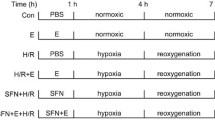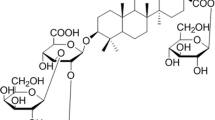Abstract
Objective
To investigate the effects of salvianolic acid A (SAA) on cardiomyocyte apoptosis and mitochondrial dysfunction in response to hypoxia/reoxygenation (H/R) injury and to determine whether the Akt signaling pathway might play a role.
Methods
An in vitro model of H/R injury was used to study outcomes on primary cultured neonatal rat cardiomyocytes. The cardiomyocytes were treated with 12.5, 25, 50 μg/mL SAA at the beginning of hypoxia and reoxygenation, respectively. Adenosine triphospate (ATP) and reactive oxygen species (ROS) levels were assayed. Cell apoptosis was evaluated by flow cytometry and the expression of cleaved-caspase 3, Bax and Bcl-2 were detected by Western blotting. The effects of SAA on mitochondrial dysfunction were examined by determining the mitochondrial membrane potential (△Ψm) and mitochondrial permeability transition pore (mPTP), followed by the phosphorylation of Akt (p-Akt) and GSK-3β (p-GSK-3β), which were measured by Western blotting.
Results
SAA significantly preserved ATP levels and reduced ROS production. Importantly, SAA markedly reduced the number of apoptotic cells and decreased cleaved-caspase 3 expression levels, while also reducing the ratio of Bax/Bcl-2. Furthermore, SAA prevented the loss of △Ψm and inhibited the activation of mPTP. Western blotting experiments further revealed that SAA significantly increased the expression of p-Akt and p-GSK-3β, and the increase in p-GSK-3β expression was attenuated after inhibition of the Akt signaling pathway with LY294002.
Conclusion
SAA has a protective effect on cardiomyocyte H/R injury; the underlying mechanism may be related to the preservation of mitochondrial function and the activation of the Akt/GSK-3β signaling pathway.
Similar content being viewed by others
References
Li LN, Tan R, Chen WM. Salvianolie acid A, a new depside from roots of Salvia miltiorrhiza. Planta Med 1984;50:227.
Zhang L, Zhang WK, Zhao Y, Yang X, Fang L, Wang S, et al. Research progress of salvianolic acid A. China J Chin Mater Med 2011;36:2603–2609.
Fan HY, Yang L, Fu FH, Xu H, Meng QG, Zhu HB, et al. Cardioprotective effects of salvianolic acid A on myocardial ischemia-reperfusion injury in vivo and in vitro. Evid Based Complement Alternat Med 2012;2012:508938.
Yang XY, Qiang GF, Zhang L, Du GH. Myocardial protection from ischemia-reperfusion injury by salvianolic acid A in rats. Chin Pharmacol Bull 2011;27:1072–1076.
Lin L, Liu JX, Zhang Y, Li XZ, Duan CL, Lin CR, et al. Simultaneous determination of salvianolic acid A, salvianolic acid B, rosmarinic acid and lithospermic acid in dog plasma by LC-MS/MS: application to pharmacokinetic study of Salvia Miltiorrhiza extraction. World Sci Technol Modern 2012;14:1567–1571.
Lin L, Liu JX, Zhang Y, Li XZ, Lin CR, An JB. A PK/PD processing study on Chinese formulation of Shuang-Shen-Tong-Guan Prescription. World Sci Technol Modern 2012;14:1583–1589.
Li P, Ren JG, Duan CL, Lin CR, Liu JX. The effects of three components of Salviae miltiorrhizae radix on anoxia and peroxidation injuries in neonatal cardiomyocytes. Pharmacol Clin Chin Mater Med 2009;25:29–31.
Li P, Fu JH, Wang JK, Ren JG, Liu JX. Extract of paris polyphylla simth protects cardiomyocytes from anoxiareoxia injury through inhibition of calcium overload. Chin J Integr Med 2011;17:283–289.
Zheng J, Zhang XL, Zhou JL, Dang YM, Zhang JP, Liu CY, et al. Effects of microtubule disassembly on hypoxic injury of cultured cardiomyocytes. Acta Acad Med Milit Tertiae (Chin) 2006;28:617–620.
Parhamifar L, Andersen H, Moghimi SM. Lactate dehydrogenase assay for assessment of polycation cytotoxicity. Method Mol Biol 2013;948:13–22.
Burwell LS, Brookes PS. Mitochondria as a target for the cardioprotective effects of nitric oxide in ischemiareperfusion injury. Antioxid Redox Signal 2008;10:579–599.
Burwell LS, Nadtochiy SM, Brookes PS. Cardioprotection by metabolic shut-down and gradual wake-up. J Mol Cell Cardiol 2009;46:804–810.
Zamzami N, Larochette N, Kroemer G. Mitochondrial permeability transition in apoptosis and necrosis. Cell Death Differ 2005;12:1478–1480.
Javadov SA, Clarke S, Das M, Griffitths EJ, Lim KHH, Halestrap AP. Ischaemic preconditioning inhibits opening of mitochondrial permeability transition pores in the reperfused rat heart. J Physiol 2003;549:513–524.
Argaud L, Gateau-Roesch O, Muntean D, Chalabreysse L, Loufouat J, Robertet D, et al. Specific inhibition of the mitochondrial permeability transition prevents lethal reperfusion injury. Mol Cell Cardiol 2005;38:367–374.
Matsui T, Rosenzweig A. Convergent signal transduction pathways controlling cardiomyocyte survival and function: the role of PI 3-kinase and Akt. J Mol Cell Cardiol 2005;38:63–71.
Gude N, Muraski J, Rubio M, Kajstura J, Schaefer E, Anversa P, et al. Akt promotes increased cardiomyocyte cycling and expansion of the cardiac progenitor cell population. Circ Res 2006;99:381–388.
Sussman MA, Völkers M, Fischer K, Bailey B, Cottage CT, Din S, et al. Myocardial Akt: the omnipresent nexus. Physiol Rev 2011;91:1023–1070.
Cross DA, Alessi DR, Cohen P, Andjelkovich M, Hemmings BA. Inhibition of glycogen synthase kinase-3 by insulin mediated by protein kinase B. Nature 1995;378:785–789.
Tong H, Imahashi K, Steenbergen C, Murphy E. Phosphorylation of glycogen synthase kinase-3beta during preconditioning through a phosphatidylinositol-3-kinasedependent pathway is cardioprotective. Circ Res 2002;90:377–379.
Ohori K, Miura T, Tanno M, Miki T, Sato T, Ishikawa S, et al. Ser9 phosphorylation of mitochondrial GSK-3β is a primary mechanism of cardiomyocyte protection by erythropoietin against oxidant-induced apoptosis. Am J Physiol Heart Circ Physiol 2008;295:H2079–H2086.
Author information
Authors and Affiliations
Corresponding author
Additional information
Supported by the National Basic Research Program of China (973 Program, No. 2015CB554400)
Rights and permissions
About this article
Cite this article
Li, Xl., Fan, Jp., Liu, Jx. et al. Salvianolic Acid A Protects Neonatal Cardiomyocytes Against Hypoxia/Reoxygenation-Induced Injury by Preserving Mitochondrial Function and Activating Akt/GSK-3β Signals. Chin. J. Integr. Med. 25, 23–30 (2019). https://doi.org/10.1007/s11655-016-2747-z
Accepted:
Published:
Issue Date:
DOI: https://doi.org/10.1007/s11655-016-2747-z




